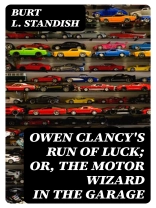In ‘Owen Clancy’s Run of Luck; or, The Motor Wizard in the Garage, ‘ Burt L. Standish crafts an exhilarating narrative that blends adventure, ingenuity, and the burgeoning fascination with automotive technology of the early 20th century. The prose, characterized by its vivid descriptions and energetic pacing, immerses readers in the riveting escapades of the young protagonist, Owen Clancy. Set against a backdrop of American optimism and industrial advancement, Standish explores themes of friendship, perseverance, and the thrill of competition, making this work a quintessential example of early American pulp fiction, which is laden with enthusiasm for progress and youthful determination. Burt L. Standish, a pen name for the prolific author William George, was emblematic of his times, capturing the spirit of adventure that defined the American youth culture of his day. His experiences in sports and affection for technology profoundly influenced his narrative style and thematic choices. Standish’s insights into the socio-economic dynamics of youth during the early 1900s lend an authentic touch to Clancy’s character and his thrilling endeavors, reflecting both the challenges and aspirations of a generation. This book is a must-read for those captivated by tales of adventure and engineering, offering a nostalgic look at the evolution of youth culture and technological progress. Readers who enjoy fast-paced stories filled with clever innovations and the trials of young heroes will find themselves thoroughly entertained by Owen Clancy’s exploits as he navigates the complexities of both the garage and life.
Circa l’autore
Burt L. Standish was the pen name of Gilbert Patten (1866–1945), an American author best known for his dime novels and serials published in ‘The American Boy’ magazine. Standish is most famously associated with the Frank Merriwell series, which captivated young readers with their tales of athleticism, heroism, and moral integrity; he was a leading architect of the ‘Merriwell type’—a character model of youthful wholesomeness and all-American vigor. Among Standish’s thrilling creations is ‘Owen Clancy’s Run of Luck; or, The Motor Wizard in the Garage, ‘ which exemplifies the author’s skill in weaving narratives centered around adventure and technological marvels of the time. Standish’s contribution to early 20th-century juvenile literature imbued with the ethic of fair play and sportsmanship significantly influenced America’s cultural landscape. His works, while serialized pulpy entertainment, also reflected the country’s shifting values during the industrial age—offering escapism, virtue, and excitement to his young readers. Standish’s literary style was energetic and straightforward, maintaining suspense and action to keep pages turning. His work remains an essential artifact in the study of popular literature and its role in shaping American youth culture during that era.












